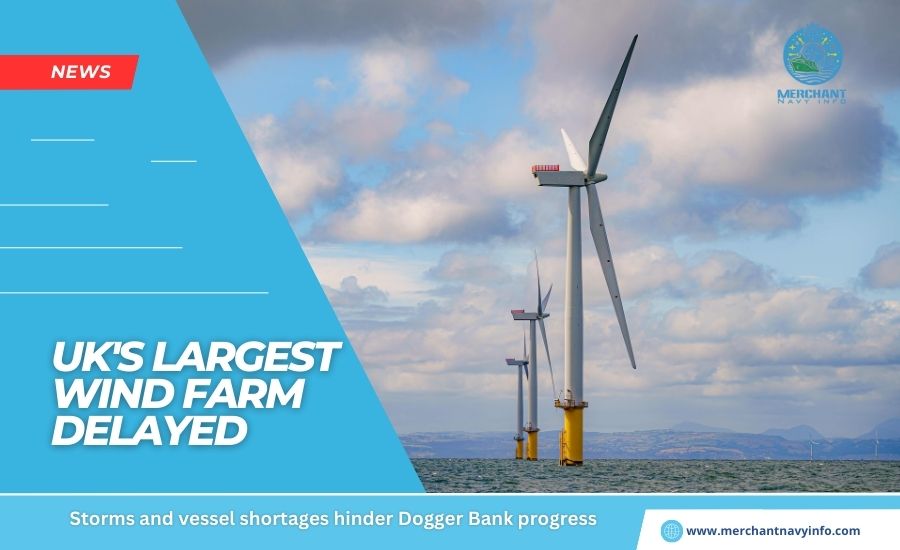
Storms and Chronic Lack of Vessels Are Hampering Progress at Dogger Bank.
SSE, the power company behind the Dogger Bank site, has announced that the completion of Britain’s largest offshore wind farm is delayed by a year. The need for more construction ships is the main cause behind this delay. The project has faced significant disruption due to bad weather and storms. Also, a shortage of vessels capable of building the turbine towers.
Two key ship types are in short supply. Foundation vessels that pour the 1,000-tonne foundations and the installation vessels that install the turbine towers.
SSE’s spokesperson stated that adverse weather conditions have impeded the installation process for turbines on Dogger Bank A. Additionally, the lack of available vessels and delays in the supply chain have caused further setbacks. The company has recently received notification of additional vessel unavailability in the upcoming weeks, which increases the likelihood that full operations will not be achieved until 2025. However, they expect the wind farm project’s returns to be minimally impacted.
In its latest results update for Q4 2023, SSE informed investors that it is collaborating closely with “its supply chain partners to enhance the current installation rates of turbines. The company plans to provide a further update on progress in May.
According to the update, SSE’s earnings per share for investors are expected to reach 150p. However, this figure is lower than the previously anticipated amount. The output of renewable power has fallen short of expectations by 15%.
Dogger Bank Project
Dogger Bank is an area of sandbanks in the southern North Sea spanning UK, German, Danish and Dutch waters. Its relatively shallow waters, between 60 and 200 feet deep, make the site ideal for installing wind turbines.
Once completed, Dogger Bank will become the world’s largest offshore wind farm, with a generation capacity of 3.6 gusted, enough to power six million homes. The wind farm will be operated by SSE’s partner, Equinor, and is expected to have a lifetime of 35 years.
Vessel Shortages For Wind Farm Pose Industry Challenge
Shortages of wind farm construction vessels are becoming a global problem. Danish energy firm Orsted’s surprise decision to cancel two offshore wind farms off New Jersey last November was “largely based on big delays securing the ship it needed to build the project, company officials said.
A recent report from Allianz Commercial said the global wind industry needed to spend $20 billion on 200 new wind farm installation vessels.
It said: “The increasin” size of wind turbines is perhaps the most striking change the industry has seen in recent years.
“In the last 20 years, they have almost quadrupled in height, from around 70m/230ft to 260m/853ft – nearly three times taller than the “Statue of Liberty.
“Rotor diameters of wind farm turbines have increased fivefold in the past 30 years. This increasing size of turbines has introduced corresponding exposures, with larger components, machinery, and vessels required for their installati” n.
“A bigger fleet of specialist vessels will be required to support global deployment as most specialist vessels currently operate out of Europe. There is an urgent need to expand port facilities to accommodate the required increase in vessel numbers.”
SSE’s Setbacks in the UK’s Green Energy Transition
SSE was formed from mergers between power companies across the UK. It now supplies power to communities across the northern Scottish islands. Such as Shetland and Aberdeen, and customers in southern England in areas including PortsmoUK’sand the Isle of Wight.
The company also owns the high voltage transmission lines across the north of Scotland and Scottish islands, plus a fleet of around ten gas-fired power stations in Scotland and England.
The delay is the latest setback for the UK’s attempts to move to low-carbon electricity supplies.
Plans to construct the Hinkley Point C nuclear power plant have been delayed until 2030. Despite being scheduled to begin operations in the next three years.
There were intentions to construct up to ten additional nuclear power stations by this time. But only Sizewell C is progressing towards that goal. The National Grid has not been extended to handle the electricity generated by wind turbines. It results in the need to turn off several turbines during periods of high wind.










